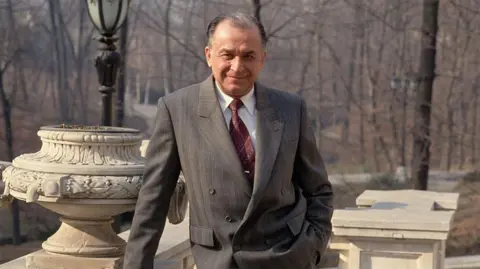BBC News in Bucharest
 Peter Turnley/Corbis/VCG via Getty Image
Peter Turnley/Corbis/VCG via Getty ImageThe Ion Ilisku, a figure named with the birth of modern Romania, died at the age of 95.
A career politician who shaped the transition from the communism of the country in democracy was both hopes and a deep divisive appearance in Romanian politics.
His death on 5 August marks the end of life spent in the heart of some of the most dramatic and controversial moments of Romania.
Political analyst Taodor Tita says, “To understand Ilisku, you must understand the complexity of Romania’s 1990s.”
“He was neither an ordinary hero, nor a straight villain. He adopted the contradictions of the country that struggled to strengthen himself again during his past being haunted.”
The ILIESCU increased prominently amidst the chaos of the December 1989 revolution, when Nikole Sesku suddenly and violent ends in decades of decades.
Initially it was distinguished as a person who would take Romania to a new Democratic era, the legacy of Ilisku soon became more complicated.
His leadership carried forward the nation through the early years of democracy and with the NATO and the final integration with the European Union, creating his stable hand.
Nevertheless, as TEODOR TITA states: “Their chairmanship was also marked by the moments that still reduces the collective memory of Romania – suppressing protests in 1990, violent minerals, and their clear reluctance to break down completely with old communist structures. Their clear reluctance to break up completely.
 Getty images Georges Merillon/Gamma-Rafo
Getty images Georges Merillon/Gamma-RafoBorn on 3 March 1930 in the city of Danube in Olttenita, Ilisku studied engineering in Moscow, Russia during the Stalin era, where he became active in Romanian students political circles.
His time in the Soviet Union will later speculate fuel-never proved-he had ties with high ranked communist data, including Mikhail Gorbachev.
After returning to Romania, IlieScu rose rapidly within the Communist Party, held positions in publicity and youth policy.
But his reformist inclination eventually made him a goal for Ceausescu, who marginalized him from the upper rank of the party. Till the 1980s, ILIESCU was out of politics and was working as a director in the academic publication house associated with a government.
During the revolution of 1989, his emergence, which lasted from 16–25 December and observed that more than 1,000 people were killed, some were seen as opportunistic, but for others, it was a stable appearance between chaos.
As the leader of the National Salvation Front (FSN), a political organization that was formed during the revolution became the interim President of IlieScu Romania and oversee the rapid disruptions of CeausESCU rule.
On the Christmas day, the squad was fired after a test at a military base lasting two hours, Nicole Sesesku and his wife was killed by firing.
In 1990, he won Romania’s first Democratic election in more than 50 years, with 85% of the votes. But the campaign was married against liberal rivals from disintegration and state-based publicity.
Later that year, ILIESCU faced growing opposition from students and opposition supporters. The cruel road violence for the mine for miners to land in the capital to “restore order” is known as Minrids, during which dozens were injured and many were killed.
He gave another full tenure after winning the 1992 elections, then returned to the last presidential post between 2000 and 2004.
Turbulent years followed the revolution. Deep roots and insidious impressive figures, continued dating back in the Communist era, and Ilisku’s presidential post was marked by comprehensive corruption.
Critics argue that their reluctance – frightened Gupta police – to fully improve the justice system or to face the heritage of the secure.
For more than three decades from the revolution, Romania still struggles with political corruption and is one of the poorest and most corrupt members of the European Union – a reality that returns to the rule of ILISCU.
The office saw progress on their subsequent years of Western integration of Romania – including NATO membership and closing the European Union’s conclusion talks. There were also improvements in the market, allowing small businesses to open, and Romania adopted its first democratic constitution in 1991, which still shapes the country.
But in the early 1990s, ILIESCU answered questions from questions on its role.
In 2017, he was formally motivated for crimes against humanity in relation to both the 1989 revolution and the 1990 minerals. Dragged for years without legal proceedings.
After going down, the ILIESCU remained a respected person within the Social Democratic Party (PSD), eventually named the honorary president.
He withdrew from public life in his later years, but sometimes posted political remarks on his personal blog. In May 2025, his last entry congratulated President Nikasor Dan for his election victory.
Ion Ilisku created Romania’s democracy, says Taodor Tita, but he was also “a ruthless politician who was not afraid to incite violent conflicts among the competitive parts of the society”.
“As a politician, ILIESCU was ruthless, skilled and always with an eye for history.”
